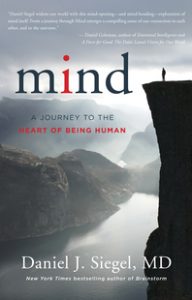Reviewed by Janay Anderson
What is the mind?
Is it different from the brain?
Of course, we would expect the mind to be clearly defined since thought, discourse, and creativity are the crux of our modern societies. However, Dr. Daniel Siegel explores a major gap in our understanding of mind: we don’t understand it. We don’t have a collective definition of the mind, which is different from the mechanistic brain, even though we engage daily in professional capacities with the mind. Dr. Siegel’s sometimes autobiographical, oftentimes exploratory book, Mind: A Journey to the Heart of Being Human reveals this very disparity: “various disciplines focusing on the mind did not have a definition of the mental” (143). However, we still manage to think we do understand the mind because we can describe what it does. A mind enables us to think, emote, and be conscious. Yet, what is the mind beyond the description of its characteristics?
Dr. Siegel defines the mind as an embodied and relational, self-organizing emergent process that regulates the flow of energy and information both within and between. His definition of mind is full of his own language that he develops throughout the book. This way of talking about the mind would not appeal to some readers: “If instead you are looking for more of this conceptual discussion, seeking a purely theory-based, subjectively-distant discussion about the mind, you’ll need to explore other more standard books rather than this one” (pg. 20). Thus, he self-selects his audience early. He sprinkles “both scientific discussions and experiential reflections” into this text and the result is that as you move through the book he subtly shifts more into a mystical or spiritual understanding of mind (pg. 20).
The solitary critique that I have of this text is that it can only be read straight through. There are simply no shortcuts for reading this book. That is to say, Dr. Siegel begins the journey into the mind quite innocently and simply in the beginning and gains complexity throughout the chapters. Bouncing around while reading the book might lead to an uninformed reader coming across sentences like these: “This is what integration entails—the linkage of differentiated positions along the energy probability curve” (pg. 285), which makes much more sense in the flow of his writing over time.
Janay Anderson studies French and pre-medicine at Columbia University and is set to graduate in May of 2017. She has done oncology research in New York City for two summers on small protein receptors that are implicated in the pathology of certain lung cancers and continues to work in the Biological sciences department at Columbia University. In addition to working for SPT, she writes reviews for the International Journal of Psychotherapy.
Want to buy Dan’s new book? SPT subscribers receive 25{f4ab6da3d8e6a1663eb812c4a6ddbdbf8dd0d0aad2c33f2e7a181fd91007046e} off and free shipping just by using our special code when you order directly from W. W. Norton & Company 
or
you can simply CLICK on the Amazon link below.








